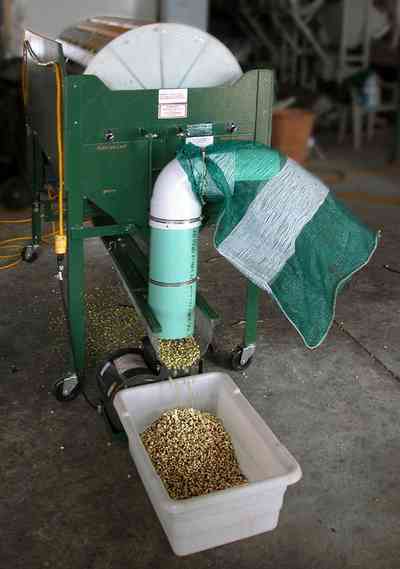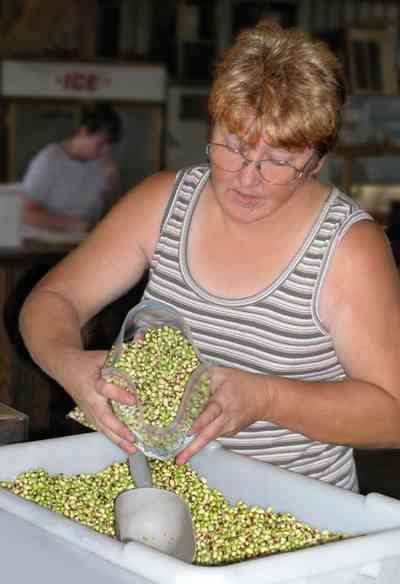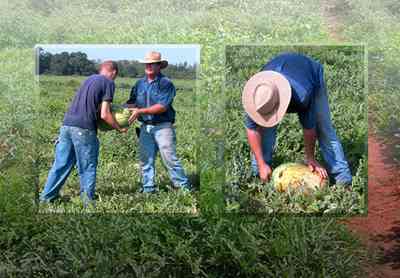-

Customers buy bags of peanuts at the Holland barn.
-

Piles of watermelons are purchased from July to August at the barn.
-

Bruce and his family have a complete peanut harvest from planting through boiling.
-

The 600 acre farm is divided into summer crops. The butterbean field is adjacent to the barn.
-

Melvin Holland lends a hand during the butterbean harvest.
-

Charles Holland supervises the bagging of beans.
-

Bruce Holland inspects the new butterbean crop.
-

A crew of local workers pick the beans.
-

Pods are cleaned automatically.
-

The cleaned peas are packed for sale.
-

Zipper cream peas are a popular variety. Some seed varieties appear to have no distinguishing eye color or body color other than that of white or pale, these seeds are said to have “no color”, and they are classified as “Creams”. The color of the seed itself determines the color of the broth when cooked. The darker the seed color the darker the broth. Seed with “no color”, white or pale, gives a clear broth. Zipper Cream Peas have a clear colored broth. The name Zipper came from the ease of unzipping the pea pod to expose the seed.
-

Holland Farms produces a variety of crops throughout the year. Listed below are prices for vegetables that are currently being harvested. For further information, call - 675-6876.
-

Bruce Holland inspects the cucumbers planted along a low fence.
-

Yellow crookneck squash grow in the garden south of the main barn.
-

Watermelons are low in calories and very nutritious. Watermelon is high in lycopene, second only to tomatoes.
-

Watermelon is also high in Vitamin C and Vitamin A, in the form of disease fighting beta-carotene. Research also suggests that the red pigmented foods provide this protection.
-

Squash are harvested when five to six inches long. Keep the squash picked as flavor and texture will be inferior if the vegetable is left to grow to enormous size on the plant.

 Customers buy bags of peanuts at the Holland barn.
Customers buy bags of peanuts at the Holland barn. Piles of watermelons are purchased from July to August at the barn.
Piles of watermelons are purchased from July to August at the barn. Bruce and his family have a complete peanut harvest from planting through boiling.
Bruce and his family have a complete peanut harvest from planting through boiling. The 600 acre farm is divided into summer crops. The butterbean field is adjacent to the barn.
The 600 acre farm is divided into summer crops. The butterbean field is adjacent to the barn. Melvin Holland lends a hand during the butterbean harvest.
Melvin Holland lends a hand during the butterbean harvest. Charles Holland supervises the bagging of beans.
Charles Holland supervises the bagging of beans. Bruce Holland inspects the new butterbean crop.
Bruce Holland inspects the new butterbean crop. A crew of local workers pick the beans.
A crew of local workers pick the beans. Pods are cleaned automatically.
Pods are cleaned automatically. The cleaned peas are packed for sale.
The cleaned peas are packed for sale. Zipper cream peas are a popular variety. Some seed varieties appear to have no distinguishing eye color or body color other than that of white or pale, these seeds are said to have “no color”, and they are classified as “Creams”. The color of the seed itself determines the color of the broth when cooked. The darker the seed color the darker the broth. Seed with “no color”, white or pale, gives a clear broth. Zipper Cream Peas have a clear colored broth. The name Zipper came from the ease of unzipping the pea pod to expose the seed.
Zipper cream peas are a popular variety. Some seed varieties appear to have no distinguishing eye color or body color other than that of white or pale, these seeds are said to have “no color”, and they are classified as “Creams”. The color of the seed itself determines the color of the broth when cooked. The darker the seed color the darker the broth. Seed with “no color”, white or pale, gives a clear broth. Zipper Cream Peas have a clear colored broth. The name Zipper came from the ease of unzipping the pea pod to expose the seed. Holland Farms produces a variety of crops throughout the year. Listed below are prices for vegetables that are currently being harvested. For further information, call - 675-6876.
Holland Farms produces a variety of crops throughout the year. Listed below are prices for vegetables that are currently being harvested. For further information, call - 675-6876. Bruce Holland inspects the cucumbers planted along a low fence.
Bruce Holland inspects the cucumbers planted along a low fence. Yellow crookneck squash grow in the garden south of the main barn.
Yellow crookneck squash grow in the garden south of the main barn. Watermelons are low in calories and very nutritious. Watermelon is high in lycopene, second only to tomatoes.
Watermelons are low in calories and very nutritious. Watermelon is high in lycopene, second only to tomatoes. Watermelon is also high in Vitamin C and Vitamin A, in the form of disease fighting beta-carotene. Research also suggests that the red pigmented foods provide this protection.
Watermelon is also high in Vitamin C and Vitamin A, in the form of disease fighting beta-carotene. Research also suggests that the red pigmented foods provide this protection. Squash are harvested when five to six inches long. Keep the squash picked as flavor and texture will be inferior if the vegetable is left to grow to enormous size on the plant.
Squash are harvested when five to six inches long. Keep the squash picked as flavor and texture will be inferior if the vegetable is left to grow to enormous size on the plant. One Tank of Gas
One Tank of Gas